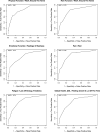Needs assessments can identify scores on HRQOL questionnaires that represent problems for patients: an illustration with the Supportive Care Needs Survey and the QLQ-C30
- PMID: 20340048
- PMCID: PMC5831364
- DOI: 10.1007/s11136-010-9636-2
Needs assessments can identify scores on HRQOL questionnaires that represent problems for patients: an illustration with the Supportive Care Needs Survey and the QLQ-C30
Abstract
Purpose: A barrier to using HRQOL questionnaires for individual patient management is knowing what score represents a problem deserving attention. We explored using needs assessments to identify HRQOL scores associated with patient-reported unmet needs.
Methods: This cross-sectional study included 117 cancer patients (mean age 61 years; 51% men; 77% white) who completed the Supportive Care Needs Survey (SCNS) and EORTC QLQ-C30. SCNS scores were dichotomized as "no unmet need" versus "some unmet need" and served as an external criterion for identifying problem scores. We evaluated the discriminative ability of QLQ-C30 scores using receiver operating characteristic (ROC) analysis. Domains with an area under the ROC curve (AUC) >or= .70 were examined further to determine how well QLQ-C30 scores predicted presence/absence of unmet need.
Results: We found AUCs >or= .70 for 6 of 14 EORTC domains: physical, emotional, role, global QOL, pain, fatigue. All 6 domains had sensitivity >or= .85 and specificity >or= .50. EORTC domains that closely matched the content of SCNS item(s) were more likely to have AUCs >or= .70. The appropriate cut-off depends on the relative importance of false positives and false negatives.
Conclusions: Needs assessments can identify HRQOL scores requiring clinicians' attention. Future research should confirm these findings using other HRQOL questionnaires and needs assessments.
Figures
Similar articles
-
Using the EORTC-QLQ-C30 in clinical practice for patient management: identifying scores requiring a clinician's attention.Qual Life Res. 2013 Dec;22(10):2685-91. doi: 10.1007/s11136-013-0387-8. Epub 2013 Mar 27. Qual Life Res. 2013. PMID: 23532341 Free PMC article.
-
Identifying cutoff scores for the EORTC QLQ-C30 and the head and neck cancer-specific module EORTC QLQ-H&N35 representing unmet supportive care needs in patients with head and neck cancer.Head Neck. 2016 Apr;38 Suppl 1:E1493-500. doi: 10.1002/hed.24266. Epub 2015 Nov 13. Head Neck. 2016. PMID: 27111696
-
Identifying health-related quality of life cut-off scores that indicate the need for supportive care in young adults with cancer.Qual Life Res. 2022 Sep;31(9):2717-2727. doi: 10.1007/s11136-022-03139-6. Epub 2022 Apr 27. Qual Life Res. 2022. PMID: 35476170 Free PMC article.
-
Psychometric validation of the Moroccan version of the EORTC QLQ-C30 in colorectal Cancer patients: cross-sectional study and systematic literature review.BMC Cancer. 2021 Jan 27;21(1):99. doi: 10.1186/s12885-021-07793-w. BMC Cancer. 2021. PMID: 33499819 Free PMC article.
-
The EORTC QLQ-C30 Summary Score as Prognostic Factor for Survival of Patients with Cancer in the "Real-World": Results from the Population-Based PROFILES Registry.Oncologist. 2020 Apr;25(4):e722-e732. doi: 10.1634/theoncologist.2019-0348. Epub 2019 Oct 31. Oncologist. 2020. PMID: 32297435 Free PMC article. Review.
Cited by
-
Identifying changes in scores on the EORTC-QLQ-C30 representing a change in patients' supportive care needs.Qual Life Res. 2015 May;24(5):1207-16. doi: 10.1007/s11136-014-0853-y. Epub 2014 Nov 15. Qual Life Res. 2015. PMID: 25398495 Free PMC article.
-
Lower Patient Ratings of Physician Communication Are Associated With Unmet Need for Symptom Management in Patients With Lung and Colorectal Cancer.J Oncol Pract. 2016 Jun;12(6):e654-69. doi: 10.1200/JOP.2015.005538. Epub 2016 May 24. J Oncol Pract. 2016. PMID: 27221991 Free PMC article.
-
Prognostic features for quality of life after radical cystectomy and orthotopic neobladder.Int Braz J Urol. 2016 Nov-Dec;42(6):1109-1120. doi: 10.1590/S1677-5538.IBJU.2015.0491. Int Braz J Urol. 2016. PMID: 24893915 Free PMC article.
-
Identifying unmet needs and limitations in physical health in survivors of Head and Neck Cancer.Eur J Cancer Care (Engl). 2021 Sep;30(5):e13434. doi: 10.1111/ecc.13434. Epub 2021 Mar 11. Eur J Cancer Care (Engl). 2021. PMID: 33709466 Free PMC article.
-
A comparison of the FACT-G and the Supportive Care Needs Survey (SCNS) in women with ovarian cancer: unidimensionality of constructs.Qual Life Res. 2012 Jun;21(5):887-97. doi: 10.1007/s11136-011-9993-5. Epub 2011 Aug 27. Qual Life Res. 2012. PMID: 21874313
References
-
- Aaronson NK, Snyder C. Using patient-reported outcomes in clinical practice: Proceedings of an international society for quality of life research conference. Quality of Life Research. 2008;17:1295. - PubMed
-
- Donaldson G. Patient-reported outcomes and the mandate of measurement. Quality of Life Research. 2009;18:1303–1313. - PubMed
-
- Aaronson NK, Cull AM, Kaasa S, Sprangers MAG. The European Organization for Research and Treatment of Cancer (EORTC) modular approach to quality of life assessment in oncology: An update. In: Spilker B, editor. Quality of life and pharmacoeconomics in clinical trials. 2. Philadelphia: Lippincott-Raven; 1996. pp. 179–189.
-
- Velikova G, Booth L, Smith AB, et al. Measuring quality of life in routine oncology practice improves communication and patient well-being: A randomized controlled trial. Journal of Clinical Oncology. 2004;22:714–724. - PubMed
-
- Gustafson DH. Needs assessment in cancer. In: Lipscomb J, Gotay CC, Snyder C, editors. Outcomes assessment in cancer: Measures, methods, and applications. Cambridge: Cambridge University Press; 2005. pp. 305–328.
MeSH terms
Grants and funding
LinkOut - more resources
Full Text Sources



